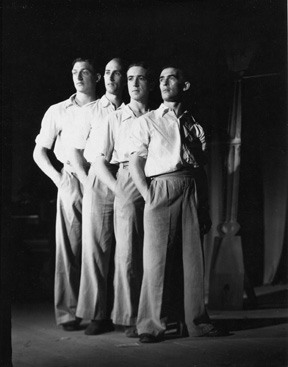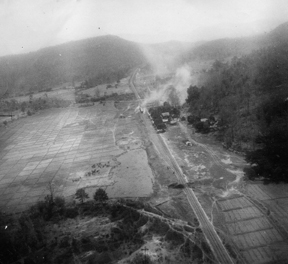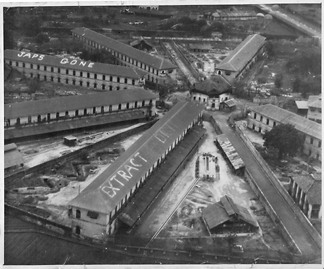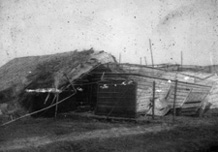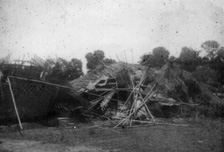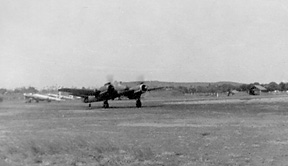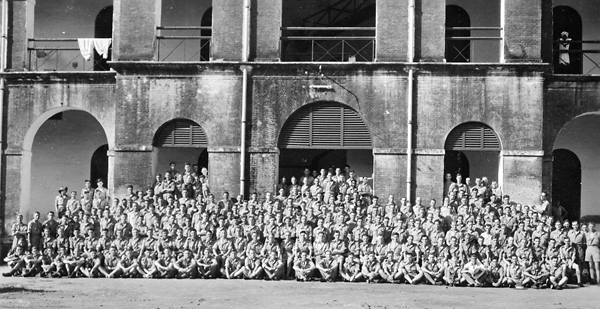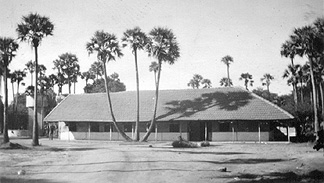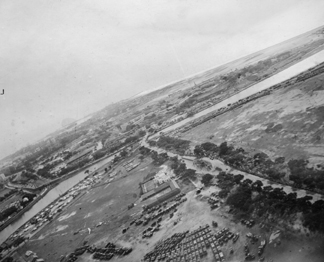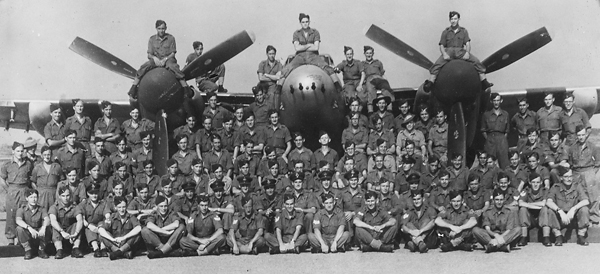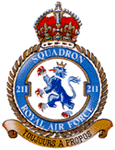 |
 |
|||||||||||||||||||||||||||||||||||||||||||||||||||||||||||||||||||||||||||||||||||||||||||||||||||||||||||||||||||||||||||||||||||||||||||||||||||||||||||||||||||||||||||||||||||||||||||||||||||||||||||||||||||||||||||||||||||||||||||||||||||||||||||||||||||||||||||||||||||||||||||||||||||||||||||||||||||||||||||||||||||||||||||||||||||||||||||||||||||||||||||||||||||||||||||||||||||
|
Operations in India and Burma 1943 to 1945 In 2001 Eveline Marsh-Collis made a wonderful contribution to the later history of 211 Squadron. With the help of her family, her late husband’s photo album (with its rich collection of photographs), and a typed report recording the Squadron’s operations from 1943 to 1945 were made available to me for use on this site, through Adrian Fryatt, son of 211 Squadron armourer the late Jim Fryatt. The origins of the history so carefully preserved over the years by Desmond Marsh-Collis and his family came to light in late 2003, when the late Peter Spooner recognized the typed report as his own, as explained on their pages. Thanks are also due to Dennis Spencer DFC who by an accident of transcription came briefly to be identified as “Peter Spooner”! In the presentation that follows, the text is as it first appeared on site, with my corrections of spelling, apparent transcription errors and added comments in the usual style [thus]. Thanks to Peter Spooner, a number of dated and briefly identified operational photographs from his personal collection are now included at appropriate points in the narrative. For these I have drafted rather fuller captions, compiled from a range of sources, including the Operations Record Book (ORB) where a number of these images are also to be found. Peter passed away in September 2008. TWO HUNDRED AND ELEVEN SQUADRON ROYAL AIR FORCE 1943 From October 1943 to August 1944 the Commanding Officer was W/Cdr PE Meagher DSO DFC. In November, the Squadron moved to Ranchi, Bihar to carry out its pre-operational training. The Flight Commanders began to experiment with Rocket Projectiles [RP] using a modified Blenheim Reflector Sights as the correct RP gun sight was then unavailable in SEAC. On November 24th, five Beaus demonstrated low level air tactics to a nearby Sikh regiment. The training programme consisted of lectures on evasion and the military situation in Burma, low level navigation, RP firing, Army co-operation and Army strikes on the airfield. The Army was impressed by the accuracy and penetration of armour piercing rockets. During training there were 5 major accidents killing 4 pilots and 2 navigators. 1944 During the last week of January, the Squadron moved to Bhatpara. To welcome the Air Party was the Ranchi charwallah sitting patiently at one end of the runway. The Supreme Allied Commander, Lord Louis Mountbatten visited the Squadron on February 8th. The first operation from Bhatpara was a coastal reconnaissance to Pagoda Point. This was also used as a consumption test anticipating the long range offensives of April 1944. Acknowledging the accuracy of the Jap ground defences, the Squadron began to evolve its operational policy. It was decided that Rhubarbs by single aircraft, rather than formations were preferable as transport targets rarely justified the use of more than one aircraft, which was less vulnerable to Ack-Ack fire. Normally, patrols were flown at tree top height. Low level navigation in this theatre was a new science and the Squadron was able to develop its own technique. The Japanese Air Force and the difficulty of locating small transports on Burma's primitive roads encouraged navigators to look out of the office window. On February 15th the CO was intercepted by 4 Oscars. He retaliated with a salvo of rockets which missed and destroyed 2 of the bandits with his cannon. Altogether 21 Oscars were encountered on that date. Another Beaufighter [LZ122] was hit by heavy Ack-Ack at Padaung. After the navigator had baled out, the pilot landed successfully in the paddy fields. This crew was recovered from Rangoon Gaol following the “Dracula” operation of May 2nd 1945. In February a moving train was derailed when hit by a pair of 60lb rockets. A formation RP strike on the Mandalay Marshalling Yards, with intense opposition, was reported by Third TAF as “A Great Success”. The difficulty of maintaining height on one engine was proved by 2 losses, both being the result of enemy action. Once an aircraft had crossed the Arakan Hills and descended into Central Burma engine failure was disastrous. Following some intensive practice at Bhatpara a successful strike on 3 airfields of the Rangoon Group Zayatkwin, Hlegu, and Hmawbi, initiated and planned by the Squadron was carried out on March 6th. The formation of 6 Beaus which participated was intercepted by many aircraft of Japanese Air Force never the less, it destroyed or damaged 6 aircraft, against the loss of one. There was another airfield strike on March 19th but neither Meiktila nor Amsekan produced so many targets as Rangoon. One Army 01 [an “Oscar” - Nakajima Ki 43 Hayabusa] was destroyed and a bomber trying low level evasion struck a hill. Considering the skillful dispersal of Jap aircraft, it seemed that fighter strikes helped by the Beau's silent approach, were more effective than bombing airfields. By then the Squadron was concentrating on offensive patrols on roads, railways and waterways. Many of these Rhubarbs were apparently unproductive, but their cumulative effect on the Japs slender communications is well known. The toll of locomotives or motor transport mounted steadily. During the operational period, the Squadron carried out Convoy Escorts, PSR searches, Army close support, photographic reconnaissance and struck marshalling yards, docks and spot targets, dropping Nickels [leaflet dropping via the flare chute] as a side line. Jack of all trades and master of more than one. In March it lost 6 aircraft from an average strength of 14. Following a Jap offensive in the Imphal Kohima Sector and the operation of British troops in North Burma a detachment of 13 aircraft advanced to Nazir on the NAF Peninsula, whence it operated from April 2nd to April 11th. Nazir lacked night flying facilities so Ramu was used for the first night operations. It was found that navigation and cannon attacks presented no especial difficulties, during the moon period although the Japs took advantage of local bad weather and drove their transports without lights. To patrol the Burma-Siam Railway and strafe Chiengmai airfield special long range belly tanks which the Squadron had been experimenting with for several months were used. Returning to Bhatpara on April 11th the Squadron scored many successes on the roads and railways between Kalewa and Lashio. In April the number of sorties increased to 108 with an average duration of 4 hours 10 minutes. After a productive rail patrol on April 28th the CO lost his section of 4 aircraft in thick haze. He was jumped by 4 aircraft but destroyed one and damaged another. During the dogfight, the other Oscars collided presumably an unintentional form of Hari-Kiri. The CO’s aircraft was itself damaged but returned safely. May was an exceptionally busy month due to an intensive effort before the monsoon set in. During the last week of May the entire Squadron moved to Feni where it was accommodated by 177 Squadron until the latter's withdrawal to Ranchi. Operations never ceased. 48 hours after the last aircraft left Bhatpara the strip was made unserviceable by heavy rain. On May 28th, one Beaufighter was shot down by P51s. To many crews, June presented their first experience of the “worst flying conditions in the world”. Naturally without meteorological forecasts, the number of abortives increased but a daily scale of 4 operations was maintained. “Parni” [water] in the petrol and technical equipment was a source of trouble largely overcome by excellent servicing. On the night of June 2nd, one aircraft returning from abortive patrol attempted to land at Chittagong in adverse weather and crashed into the sea. It is believed the pilot mistook the lights of a hospital ship for the flare path. The Navigator was picked up but the pilot and the passenger F/O Bishop the Intelligence Officer drowned. The loss of three crews and the withdrawal of 177 Squadron threw more work on to the remainder of the Squadron. On one occasion the ten available crews flew 20 sorties in 24 hours. The highlight of June was an attack on the Mandalay waterfront while many MT vehicles added to the game bag. To Chiringa in the first week of July the Squadron made its fifth move under adverse weather. On the Feni-Chiringa Road 4 bridges collapsed and a similar misfortune held up stores which had been shipped to Cox's Bazaar. Rations, water and petrol were ferried across flooded rivers in Kistus and Sampans. The airmen accepted these difficulties philosophically and the move was immortalised in a monologue by Cpl. Bond of the Rockettes Concert Party in “My kit’s at Cox's Bazaar”. Operations ceased only for 48 hours. In July the Squadron attacked what is probably a command record of 47 locos and 75 MT vehicles. Strafing Thazi Junction on August 5th F/Sgt Leach pilot was wounded in the chest and shoulder. with the help of his navigator F/O J.D. Callaghan, he returned safely to Chiringa and made a perfect landing. The Squadron celebrated its first anniversary with an informal party. The date did not coincide however, with the explosion of the Pyrotechnic Stores at the end of August. On August 19th W/Cdr PE Meagher DSO, DFC, was posted to 901 Wing at Chiringa, the command of 211 Squadron being assumed by S/Ldr. JSR Muller-Rowland DSO, DFC, and Bar.
Toungoo-Mandalay railway 12 August 1944 (RAF official via Peter Spooner) [As we have seen, photographs both official and personal were shared freely. This and the following aerial camera photographs are from Peter Spooner’s collection. Matching the pencil notes on the back of each photo with the 211 Squadron Operations Record Book entries provides a slightly fuller account. On this occasion six 211 Squadron Beaufighters were tasked to attack the railway yards and then proceed on individual patrols. P/O FT Gamlin and W/O BB Mearns in Beaufighter Z-Zebra failed to return from this operation. The pair reported engine trouble by VHF radio and forced-landing into captivity. Fortunately, both survived.] Hit by LMG fire from Thanyazat Railway station on August 27th, one aircraft ditched off Green Island. This crew was also recovered from Rangoon. The paucity of targets in August was ascribed to recent successes apparently damaged locomotives were being replaced, while Jap transport drivers were being more cautious. contributory factors were the return of 177 Squadron and the restrictions of operations to North Burma. The Japanese withdrawal from Tamu and Imphal released Ack-Ack guns for the defence of Railways and other objectives. September was marked by a long shipping strike in the Gulf of Martaban when the Squadron destroyed or damaged 14 vessels including 2 gun boats approx. 5,000 tons [see also W/O James Oblein’s narrative]. On September 12th Air Marshal Coryton commanding 3rd TAF visited Chiringa and congratulated the Squadron on its successes. One aircraft ditched near Elephant Point. The crew was picked up 24 hours later by an ASR launch with air cover. The Jap Air Force appeared occasionally but from then on its opposition decreased, dwindling completely at the close of the Burma campaign. A survey of adjudicated claims reveals that 211 Squadron destroyed 5 bombers and 11 fighters and damaged 5 bombers and 4 fighters excluding 2 probables during the operational period. It was proved on several occasions that during low deck level and jettisoning its rockets a Beau could outstrip the Japanese fighters. S/Ldr JSR Muller-Rowland DSO, DFC & Bar was repatriated in October. His place was taken by S/Ldr HE Martineau who had joined the Squadron in September after a tour of operations in the Middle East. The scarcity of worthwhile targets persisted. The destruction of several river steamers enlivened offensive patrols of the Bassein Delta. While the Squadron Tiger Moth was dropping newspapers to local Army Units on November Ilth its propeller fell off. The light machine force-landed in the Chittagong Jungle. It was 2 days before the pilot and the passenger walked into Chiringa.
[Born in Great Tew, Oxfordshire in 1917, the son of Martha May and Oscar Thomas Coles. Rodney joined the RAF just before World War II. After a tour in Coastal Command, he was posted to Canada where he was associated with retrieving aircraft from Seattle to Canada under arcane lend-lease arrangements. He was later posted to India. First appearing in the Squadron record on 10 October 1944, Coles and his Nav/W F/O RS Painter in Beaufighter NE540 ‘Z’ failed to return from the 18 October 1944 strike on Mingaladon. It was their third sortie together. Posted missing, they are commemorated on the Singapore Memorial.] November and December were more productive months due especially to the exploration of new roads in the Chiengmai Sector [sic: province SW of and adjoining Chiengrai]. On a moon patrol the first locomotive for 2 months was severely damaged with 60lb rockets. F46 cameras began to be used although the photographic section was handicapped by the provision of second rate film and 8 inch rather than 5 inch lenses. Previously G45 cine guns had been tried unsuccessfully. When 27 Squadron came to Chiringa, the Squadron began to regularly have operational stand downs. An RP range on Sandip Island was used extensively. Later the Squadron scored its first success against the newly developed truck locomotive. One aircraft discovered 6 of them at Bhir Ferry fired 4 and damaged two that remained.
[Four 211 Squadron Beaufighters patrolled the road, attacking motor transport, steam rollers and other road traffic. All returned safely to Chiringa. Closer examination shows that the bridge in left middle ground has already been destroyed and the small hut on the edge of the river vegetation just this side of the bridge is damaged. A solitary figure stands below the road embankment near a drain.]
[On the afternoon of 28 November, F/Sgt Bell and F/Sgt Smith carried out a shipping reconnaissance of the Gulf from Kyonda to Salween estuary, attacking a number of barges, returning safely.] During an air test on December 17th an aircraft spiralled into the ground. Although the scene of the crash was less than 5 miles from Chiringa, it was several hours before a rescue party in kisties could reach them. The pilot and WEM had been killed instantaneously.
[The 17 December search party included Deputy Flight Commander F/O EL Wood, the Squadron padre S/Ldr McCulloch and Squadron MO, S/Ldr John “Doc” Watson, who found the wreckage of Beaufighter LZ343. During an air test of the aircraft’s radio equipment, it was seen to spiral into the ground 4 or 5 miles West of Chiringa. The pilot, 1334151 F/Sgt AA Bell, and Wireless Mechanic 574199 Sgt WJ Lawrence did not survive. They were given a Christian burial at the scene the next day. This photograph from F/Lt TM Einboden’s collection is thought to be of that event]. Christmas '44 was set in the mould of tradition including a comic football match between the Officers and Senior NCO's a meeting of the “Salvation Army” (Sister Anna, Parker and Wagstaff cut up rough) and an elaborate dinner outside the airmen’s mess. Over the football pitch an L5 dropped Xmas cards. For the holiday each section made and operated its own bar. Many airmen described this as “their best Service Christmas”. For three crews December 25th was business as usual.
[The Squadron’s 1944 Christmas hijinks included the football match pictured above. An “air drop” by Stinson L5 Sentinel was laid on for the occasion, with aerial delivery of Christmas cards accompanied by a traditional RAF silliness: flour bombs. “Casualties” were stretchered off the field, for revival by further refreshment. About 100 Stinson Model 76 L5 Sentinels were delivered to the India/Burma theatre for use in the AOP role and as a “run-about”, being able to carry a stretcher case for example.]
Following the reduction from 300 hours to 200 hours for an operational tour, in November seven fresh crews had been posted into the Squadron in anticipation of pending departures of experienced men. Apparently among the new arrivals were the Canadian P/O JM Copeland RCAF J6611 and his Nav/W F/Sgt Donald Donaldson-Davidson RAFVR 1045219. Together they flew at least 6 sorties from 12 November, on several occasions as one of a pair with F/O GD Vardigans and F/Sgt DA Spencer. Donaldson-Davidson was born in 1923 and joined the RAF on turning 18 in 1941. He continued in the RAF post-war, appointed to a permanent commission in 1953, followed by a stint as Radar Weapons Instructor at the Lightning Conversion Unit, RAF Coltishall in 1959. Awarded the Queen’s Commendation for Valuable Service in the Air in the 1964 Queen’s Birthday Honours, Donaldson-Davidson retired a Squadron Leader in 1972. A varied career on Civvy Street drew him in later life to community service work, from which he finally retired at the age of 80, passing away aged 88 in April 2011.] 1945 [As an operational “rest” for Beaufighter Navigators, Visual Control Post duties were not popular. Dennis Spencer recalled the task in these terms: W/Cdr RCO Lovelock DFC assumed command of the Squadron on January 10th shortly before the detachment returned from Ranchi. Although eligible for repatriation, S/Ldr HE Martineau elected to complete his tour. On February 15th Grp Cpt Tomalin DFC AFC commanding No. 901 Wing carried out an operation with the Squadron. A record 128 sorties was set up producing attack on 9 locomotives and 63 MT vehicles.
In March, the Rocketeers Concert Party presented their tenth review “Further round the Bend” in Chiringa's new “Beaumont”, reputed to be the finest cinema in the Arakan. Owing to the scarcity of ENSA shows the Squadron has always been responsible for its own entertainment. In the early days the most popular was “ITBA”, a fortnightly review series. As an aircraft was attacking a train on the Mandalay Mokpalin railway all its controls except the ailerons were shot away. The crew baled out over Ramree Island and spent an eerie night in the Mangrove swamps before they reached a nearby army camp. 7211 Servicing Echelon was formed in April '45. To the airmen it was a new name for an old Unit. As the Echelon has moved ever since with its aircraft it has been possible to retain “Squadron Spirit”. To ensure the continued liaison of officers and men, one officer was delegated to each of the airmen’s bashas. On April 11th, one aircraft was shot up in the Bassein Delta. It returned safely to base where the crew baled out [see also the account of JS Mitchell DFC]. The abandoned aircraft, although trimmed to fly out to sea, circled Chiringa for one and a half hours before its engines cut out and it crashed at the foot of the Arakan Hills.
[The successful sortie of F/Lt PN Smith and W/O Webber in F-Freddie. The neg has been damaged by heat, the emulsion crazed.] The word Tavoy became synonymous with maximum endurance where the Squadron made several long patrols of the Ye-Tavoy road and coast. The record flight was 7 hours 45 minutes. During the second fortnight of April an extensive search was made for 6 motor torpedo boats which had been reported by Intelligence to be hidden near Thongira. A Beaufighter of 211 Squadron located the boats in a dried Chaung resulting in a combined strike with 177, 110 and 22 Squadrons. It was revealed later than 4 of the boats were destroyed. The Commanding Officer was able to forecast the Dracula operation and the real enthusiasm of the ground crews to ensure top line serviceability proved that the Echelon was still part of the Squadron team. On April 30th an aircraft of this Squadron patrolling the Rangoon Waterfront flew across the centre of the town and photographed the Gaol on the roof of which was painted “Japs Gone”. [Sic: afternoon of 1 May in the Squadron’s formal records of operations; and mis-recalled as 2 May by 211 Squadron pilot the late F/O Anthony Montague Browne, who took the photograph, a copy of which is seen in Nav/W W/O Ron Kemp’s account. Other well-known aerial shots show the other signs, “British Here” and “Extract Digit”, as long recorded by Rangoon Rats Lionel Hudson, Harvey Besley and others, one such being this print, kept among his memorabilia by the late Jim Oblein:
Extract digit, indeed. No marginal notes on this image to firmly date it. Date: possibly 2 or 3 May, as discussed in Ron Kemp’s narrative. Jim Oblein’s own account of the adventures of the FEPoW group marched from Rangoon Gaol by the Japanese shortly before liberation is another story altogether. The present day use of what is now the Central Prison Insein is another sad reflection on the human condition.] On “D” day May 2nd [standard service operational usage: D Day and H Hour are the appointed day and time for any operation, not just the 6 June 1944 Overlord Normandy landings], despite extremely adverse weather which turned back one formation, 7 aircraft of 211 Squadron blitzed empty gun emplacements on the banks of the Rangoon River. The Paratroop VCP assessed that no further assistance was required. In fact Dracula drew very little blood, but it was nevertheless the climax of 17 operational months. Among the prisoners of war for whom the fall of Rangoon spelt freedom, were 13 members of 211 Squadron, 8 of them completely healthy flew to Comilla where they were visited by the O/C 901 wing and F/O GE Smith the Squadron Intelligence Officer. From their stories, the fate of several other missing crews was determined, 4 men died in captivity. The Squadron arranged a big celebration at Chiringa but the ex-prisoners were unable to attend. Shortly afterwards they were repatriated. During the next week, the Squadron harassed the remnants of the Japanese Army in the Bassein Delta flying its last sortie on VE Day. It was then stood down and its Beaufighters distributed among the other Squadrons of 901 Wing. In 17 months the Squadron had destroyed 25 aircraft, 223 locomotives and 612 motor transports. It is impossible to summarise the prodigious numbers of river and coastal craft installations, military Barracks and other objectives which were attacked. 1790 sorties made up a total of 7425 operational flying hours. The original intention was the Squadron should withdraw to Trichinopoly for its conversion to Mosquito FB VI. But after the advance Air Party had left Chiringa on May 3rd the location was changed suddenly to Yelahanka near Bangalore. The inability to secure a troop train held up the move for 2 weeks.
On the night of May 14th a cyclone demolished 40% of the domestic camp. Fortunately there were no casualties, in fact, the incident was accepted with remarkably good humour. The sun rose on a scene of devastation. Some NCO's occupied their Mess, other made habitable the remains of their Bashas. Approximately 80 airmen were transferred to a disused Toc H club on the Arakan Road which they converted into what closely resembled a rest camp. The main party left Chittagong on May 25th. There is no need to describe the accommodation of Indian troop trains. After an uncomfortable but comparatively uneventful journey of 6 days, the party reached Yelahanka. In June the conversions programme arranged by 1672 CU covered all aspects of the Mosquito FB VI. Bombing, Navigation Tactics, Maintenance & Instructions. Air Exercises included single engine flying, low level cross country flights, air to air combat, fighter affiliation with Spitfires of No.4 RIAF Squadron and a dummy operation. During a fighter affiliation exercise on June 29th, a Mosquito crashed and exploded in the heart of a nearby native village killing its crew and 38 civilians. It was then laid down that affiliation exercises were not be carried out below 5,000 ft. Two days later the Squadron participated in an Air Display at Yelahanka, before a large Military audience. During an exhibition of co-ordinated aircraft flying one of them crashed and disintegrated in the target area. From Yelahanka it was impossible for everyone to have leave owing to the limited accommodation at the nearby Hill stations. Unfortunately the withdrawal from the Arakan was by no means a rest. The conversion programme was fairly intensive. Ultimately all airmen were sent on leave. At the beginning of July 6 Dominion pilots were grounded prior to their withdrawal from SEAC. Since its inception, the Squadron has had a complement of Canadian and Australian crews and the final dissolution of this partnership was regretted.
The old and the new. An anonymous Beaufighter taxiing. In the distance, left, a line up of equally anonymous, all-silver doped Mosquitoes that had taken over from it. On July 11th the Squadron shifted to St Thomas Mount, Madras, rejoining HQ 901 Wing then at Cholavaram. It was intended to take part in the invasion of Malaya landing at Port Swettenham during September. The training continued at St Thomas Mount, in addition everyone attended a short ground defence course.
[A fine shot if a little soft at high resolution. It is plain that many of the Squadron aircrew are in the second row, seated. Several others can be seen in the third row, standing, others still squat in the front row. The pilots flying badges can be seen quite well, though the single wing of the Nav/Ws is harder to spot. Noted confidently to place and date by Peter Spooner, it might be possible that this shot is in fact at Yelahanka some time in May or June 1945. Aircrew identifiable in the seated (2nd) row: In the front row, 12th from the left, is W/O Tom Taylor (pilot), next to him and 13th from the left is W/O Harry Morrell (Nav/W). The Squadron dachshund, 6th from the right, is possibly F/Lt Pete Smith DFC’s “Puggles” mentioned by Monty Walters.]
St Thomas Mount, in other words, then on the South-Eastern outskirts of the great city now known as Chennai. For the VJ celebrations [on 17 August], the Squadron threw in its hand with the Station, producing a celebration which was strongly reminiscent of Christmas (or any of the rare occasions where beer is free) .In many ways its members received the news phlegmatically. On August 20th Mosquitoes helped to carry out a victory flypast.
[A variety of aircraft took past in the flypast, and F/Lt Spooner provided a radio-style commentary.] After several false alarms Operation Bibber was laid down, the Squadron preparing to occupy Don Muang Airfield, Bangkok. At the end of August when W/Cdr. RCO Lovelock DFC was posted to No 901 Wing, W/Cdr DL Harvey formerly of 27 Squadron, became the Commanding Officer. September was an unsatisfactory month. To conserve the aircraft “hours” flying was restricted to air test. During the last week 7211 SE boarded 3 LSTs and set course for Rangoon, where apparently without reason the Sea Party had to change ship. The Echelon reached Bangkok four weeks after leaving Madras. Apart from the disorganisation at Rangoon, the voyage was uneventful, food and accommodation being quite satisfactory. Meanwhile the aircraft were serviced by 7045 and 7082 Echelons who moved from Cholavaram to the Mount. It was discovered at the last moment that Don Muang 1300 yard runway was unsuitable for the regular operation of Mosquitoes. After negotiation with Air HQ Burma the Air Party advanced to Akyab, where it carried out a brief training programme mainly formation flying. At Don Muang, the airmen worked hard to straighten out the camp but had adequate opportunities for sports and recreation. The hope that W/Cdr Meagher DSO DFC expressed in January '44 had been fulfilled, Bangkok within range!! There was a regular air service between Don Muang and Akyab done by Mosquitoes. On November 18th Air Marshal Saunders of Air HQ Burma recommended the disbandment of No. 211 Squadron. In view of the limited servicing facilities at Akyab, the Air Party entered Don Muang on November 26th and 27th, a 300 yard overshoot having been almost completed. At the end of November a reprieve was received from the Supremo who declared that No. 211 Squadron should remain at Don Muang for prestige purposes.
As first shown in Des Marsh-Collis’s image collection. The caption in Herbert Winnington’s album indicates that the group is of 211 Squadron with their groundcrew, 7211 Servicing Echelon. Between Monty Walters, Ricky Watts and Peter Kent, a number of the aircrew have been identified in this, apparently one of the last group photographs of the Squadron: 2nd row, seated, left to right: (1) W/O Ashcroft Nav/W, (2) W/O Ken Jewel Pilot, (3) W/O Ron Kemp Nav/W, (4) possibly Vic Broome Nav/W, (5) W/O Monty Walters Pilot, (6) W/O George Price Nav/W, (7) F/O Steve Catto Pilot, (10) F/Lt AMJ Kent Nav/W (11) probably W/Cdr Harvey, (13) possibly F/Lt K Wilkinson Pilot, (17) W/O Watling Nav/W, (20) W/O Bill Williams Armaments Officer. 3rd row: (2) Corporal Fitter E who looked after Monty’s aircraft, (6) possibly W/O Ray Wood Pilot, (14), W/O Ed Webber Nav/W wearing a cheese-cutter hat. 4th row: Cpl W/Mech Les Ramsay is on the far right, to the left of the Port propeller (with someone’s hands on his shoulders). Rear-most standing row: The tall figure of LAC Edward Brooks stands “at ease” (hands behind), far right, beside the Port engine nacelle. The Squadron finally disbanded on March 15th due mainly to unserviceability of Mosquitoes, caused by extremes of climate. All aircraft were flown away to Selatar and personnel were posted to various units of Burma Command.
[Note: In those cases where it has been possible to compile a personal narrative, links are provided in the usual way. Brief details of each loss are linked under Remarks, above.] In February 1950, S/Ldr JSR Muller-Rowland died in a flying accident at Bletchley [DH108 test flying]. Honours and Awards No 211 Squadron Distinguished Service Order Distinguished Flying Cross Bar to Distinguished Flying Cross Distinguished Flying Medal Mentioned in despatches The Mention in Despatches of F/Sgt S Teague 359212, Chemical Warfare Fighter, appeared in the London Gazette on 2 June 1943 (p2464) and was noted here, in the Squadron narrative history written by F/Lt PA Spooner in December 1945. An ms copy of his narrative also came to the Marsh-Collis family, who kept it safe. However, Peter Spooner’s report was apparently not preserved in the Squadron Operations Record Book of the time, nor were the losses and awards rolls, nor was there direct mention of Teague’s award of June 1943. Indeed, the Squadron did not re-form in India until August 1943: it seems most likely that Teague’s award was made for some bravery in a prior posting in 1943, rather than for an incident in service with 211 Squadron. [sic: No DL Flint is shown in any Air Force List of Officers from 1943 to 1945, one DA Flint being the only likely match among those Mentioned in despatches. F/O DA Flint 51241, an Engineer of the Technical Branch, had been so awarded as 569902 Flight Sergeant DA Flint in the London Gazette of 8 January 1943 (p44), presumably for work in 1942: that is, apparently during the period when 211 Squadron had ceased to be. Donald Albert Flint was commissioned in 1943 and advanced to Flying Officer in January 1944. He remained in the RAF post-war, the London Gazette recording his progress. Granted a permanent commission in 1948 as Flight Lieutenant in the Technical Branch, he was promoted Squadron Leader in 1954 and Wing Commander in 1961. DA Flint AMBIM 51241 rose to Group Captain in the Engineer Branch in January 1970—a career of considerable achievement. Further searches of the (sometimes still intractable) Gazette found no trace of a second war-time Mention, nor of his retirement. Sources Coles family correspondence and photograph HMSO The Air Force List issues 1943 to 1945
www.211squadron.org © D Clark & others 1998—2024 |
|||||||||||||||||||||||||||||||||||||||||||||||||||||||||||||||||||||||||||||||||||||||||||||||||||||||||||||||||||||||||||||||||||||||||||||||||||||||||||||||||||||||||||||||||||||||||||||||||||||||||||||||||||||||||||||||||||||||||||||||||||||||||||||||||||||||||||||||||||||||||||||||||||||||||||||||||||||||||||||||||||||||||||||||||||||||||||||||||||||||||||||||||||||||||||||||||||
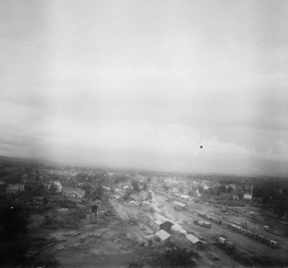
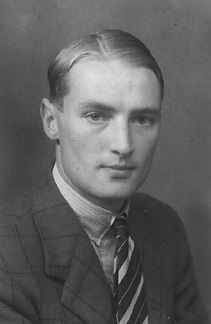
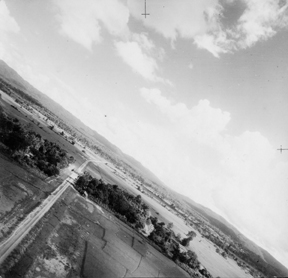
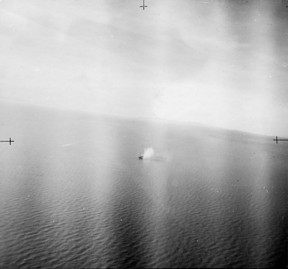
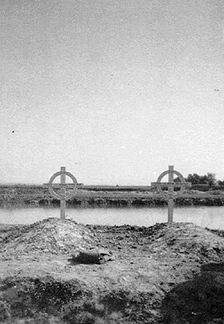
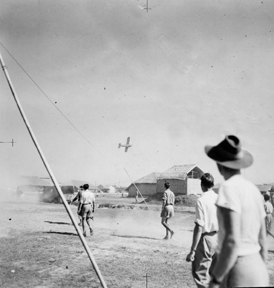
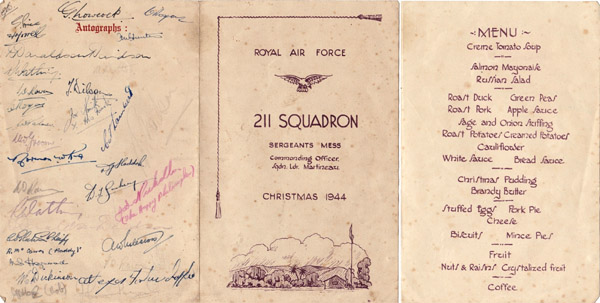 Sergeants Mess Menu Christmas 1944 (Watts collection)
Sergeants Mess Menu Christmas 1944 (Watts collection)